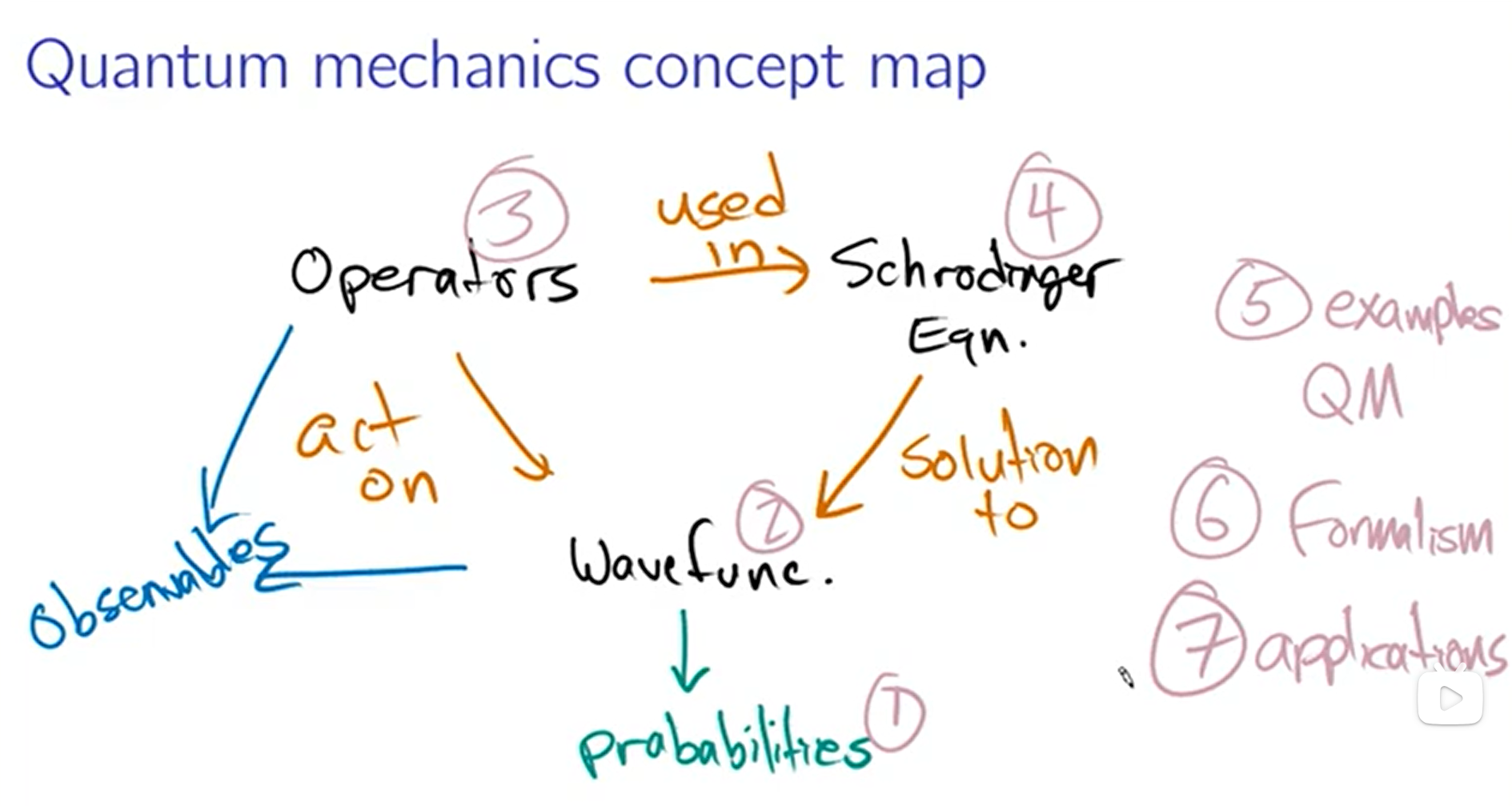The First Chapter:Wave Function
Introduction to quantum mechanics
the quantum mechanics is very fascinating,no baby can truly say they really understand it,and it is counterintuitive
There were once three unuexplainable experiments
- Blackbody spectrum
- Photoelectric effect
- Bright line spectra
To explore them,the scientists found the quantum mechanics
The domain of quantum mechanics
There are something different between classical mechanics and quantum mechanics
| classical | quantum |
|---|---|
| certain | uncertain |
| predictable | predictable |
| determine everything | probability |
When does quantum mechanics apply?
- when angular momentum \(L\)~\(\hbar\)
- when uncertainties \(\Delta p\Delta x\)~\(\hbar\)
- when uncertainties \(\Delta E \Delta t\)~\(\hbar\)
- when action \(S\)~\(\hbar\)
\(\hbar=1.05457148 × 10^{-34} kg m^2/s\)
Key concepts in quantum mechanics
The wavefunction
about its properties:
- complex function
- describe state of system
- gives probabilities
it has two part:real part of \(\psi\) and imaginary part of \(\psi\)
In math,the \(\psi^2\) is density function
In physical,the \(\psi\) is related to the probability of finding the partical at a particular point in space
Operators
it connect \(\psi\) to observables
- \(\hat{x}=x*\psi(x)\)
- \(\hat{p}=-\hbar \frac{d\psi(x)}{dx}\)
and we should know \(\hat{p}\psi\) is not "the momentum of \psi"
The Schrodinger equation
\(\hat{H}\) is Hamiltonian energy operator
\(\\\)
the common form
Quantum mechanics concept map

Complex number
Basic definition
complex number \(z=a+bi\)
\(i=\sqrt {-1} \\ i^2=-1\)
- the real parts \(Re(z)=a\)
- the Imaginary parts \(Im(z)=b\)
Complex exponentials
Polar form
Basic operations
- Addition (and subtraction):
(a+i*b)+(c+id)=(a+c)+i(b+d) - Multiplication(distribute):
(a+ib)(c+id)=(ac-bd)+i(ad+bc) - Division:
\(\frac{a+ib}{c+id}=\frac{a+ib}{c+id}\frac{c-id}{c-id}=\frac{(ac+bd)+i(bc-ad)}{c^2+d^2}\)
The polar form obeys exponential operations as you know
Magnitudes
Complex conjugate
\((a+bi)^{*}=a-bi\)
Squared magnitude(always real,positive):
\(|z|^{2}=zz^{*}=Re(z)^2+Im(z)^2\)
Geometric interpretation
Complex plane
The complex plane has the imaginary numbers as the real numbers as the x-axis and the y-axis
for example: z=3+4i
In the complex plane,the coordinates are (3,4)
so the \(|z|=\sqrt{(3)^2+{4}^2}=5\),\(z^{*}=3-4i\) and its coordinates are (3,-4)
the polar form in complex in complex plane
\(z=Re^{i\theta}\)
\(\\\)
\(tan\theta=\frac{Im(z)}{Re(z)}\)
\(\\\)
\(R=|z|\)
Complex functions
\(f(z)=f_real (z)+f_imag (z)i=f_real(Re(z),Im(z))+if_imag(Re(z),Im(z))\)
Probability in quantum mechanics
density function p(x)
\(|\psi(x)|^2\) is a p(x) of find the particle
\(P\)(Particle is between a and b)\(=\int_a^{b}|\psi(x)|^2dx\)
but in a particular x_0 ,p(x_0)=0
what does it mean
the \(|\psi|^2\) will change after measuring

there are some interpretations about it
-
the wavefunction collabses after measuring
-
the particle was at c all along
it has been proved to be wrong -
the universe split(interesting)
Probability distributions and their properties
Discrete probability
for the particular date,its probability is
the number of date/sum of number of the date
for example 1 2 3 1 2 3 3 3
the probability of 3 is \(\frac{4}{8}=\frac{1}{2}\)
most probably(mode)
Mode is the number that appears most frequently
in that example,3 is the mode
median
if the number of date is even, the median is the average of two middle value
if odd,the median is the average of the middle value
Expectation value
expectation value of \(f(x)\)
Continuous probability
it obey the probaility density p(x),at any particular point,like p(x=1)=0
Most prbably(mode)
in any exact value,p(x)=0,so there is no n mode
Median
Expectation value
expectation value of f(x)
Variance and standard deviation
the broadness of a distribution is called the variance
\(\Delta x=x-<x>\)
\(D(x)=<\Delta x^2>=\sigma^2\)
D(x) is variance
variance formulation
variance \(D(x)\) is equal to \(<x^2>-<x>^2\)
proof:
before proof,you should know:
\(E(ax)=aE(x)\)
\(\\\)
\(E(ax+b)=E(ax)+b\)
when p(x) is discrete:
when p(x) is continous:
Probability normalization and \(\psi\)
Normalization
Probability density p(x)
\(\int_{-\infty}^{\infty}p(x)dx=1\)
\(P(a<x<b)=\int_a^{b}p(x)dx\)
Wavefunction
\(\int_{-\infty}^{\infty}|\psi(x)|^2dx=1\)
\(P\)(particle is between a and b)\(=\int_a^{b}|\psi(x)|^2dx\)
to be normalizable
- \(\psi\) must be square-integrable
\(\int_{-\infty}^{\infty}|\psi|^2dx\) is finite - \(\displaystyle\lim_{x \to \infty} \psi=0\)
Time evolution
\(\frac{d\int|\psi(x,t)|^2dx}{dt}=\int \frac{\partial|\psi(x,t)|^2}{\partial t}dx =\int\frac{\partial(\psi ^{*}\psi)}{\partial t}dx=\int(\frac{\partial \psi*}{\partial t}\psi+\psi^{*}\frac{\partial \psi}{\partial t})dx\)
give the schrodinger equation
\(\\\)
so
then
\(
\int(\frac{\partial \psi*}{\partial t}\psi+\psi^{*}\frac{\partial \psi}{\partial t})dx=\int((-\frac{\hbar}{2m}\frac{\partial^2 \psi^*}{\partial x^2}+iV\frac{\psi^{*}}{\hbar})\psi+\psi^{*}(-\frac{\hbar}{2m}\frac{\partial^2 \psi}{\partial x^2}-iV\frac{\psi}{\hbar})dx=\frac{i\hbar}{2m}\int -\frac{\partial^2\psi^*}{\partial x^2}\psi+\psi^*\frac{\partial^2\psi}{\psi x^2}dx
\)
at the end
\(\int_{-\infty}^{\infty}|\psi(x)|^2dx=\frac{d\int|\psi(x,t)|^2dx}{dt}=\frac{i\hbar}{2m}\int -\frac{\partial^2\psi^*}{\partial x^2}\psi+\psi^*\frac{\partial^2\psi}{\psi x^2}dx=\int_{-\infty}^{\infty} \frac{\partial}{\partial x}(\psi^*\frac{\partial \psi}{\partial x}-\frac{\psi^*}{\partial x}\psi)dx=\frac{i\hbar}{2m}(\psi^*\frac{\partial \psi}{\partial x}-\frac{\psi^*}{\partial x}\psi)|_{-\infty}^{\infty} \)
due to\(\displaystyle\lim_{x \to \pm\infty} \psi=0\)
\(\int_{-\infty}^{\infty}|\psi(x)|^2dx=constant\)
so the time evolution does not affected normalization
Motion ,repeated measurement
Can we predicat motion in quantum mechanics?
yes ,we can know how the center of probability distribution,the center of wave function move
\(<x>=\int_{\infty}^{\infty}\psi^*x\psi dx\)
then
\(\frac{d}{dt}<x>=\frac{d}{dt}\int_{-\infty}^{\infty}x\psi(x,t)^*\psi(x,t) dx=\int x\frac{\partial}{\partial t}\psi^*\psi dx=\frac{i \hbar}{2m}\int x\frac{\partial}{\partial x}(\psi^*\frac{\partial \psi}{\psi x}-\frac{\partial \psi*}{\partial x}{\psi})dx=\frac{i\hbar}{2m}(x(\psi^*\frac{\partial \psi}{\psi x}-\frac{\partial \psi*}{\partial x}{\psi})|_{-\infty}^{\infty}-\int(\psi^*\frac{\partial \psi}{\psi x}-\frac{\partial \psi*}{\partial x}{\psi})dx)=\frac{i\hbar}{2m}\int\psi^*\frac{\partial \psi}{\psi x}dx-\int\psi\frac{\partial \psi*}{\partial x}dx=\frac{\hbar}{m}\int \psi*\frac{\partial \psi}{\partial x} dx=<\hat{v}>\)
Expectation value of operators
-
\(<\hat{v}>=-\frac{ih}{m}\int \psi^*\frac{\partial \psi}{\psi x}dx \)
-
\(<\hat{p}>=\int \psi^*(-i\hbar \frac{\partial}{\partial x})\psi\)
-
\(<\hat{x}>=\int \psi^*(x)\psi dx\)
operators:
In general
Q=something with \(\hat{x}\)..\(\hat{T}\)...
An introduction to the uncertainty principle
Position and wavelength
According to the Fourier transform
,$\Delta x \Delta\lambda \geq 1 $
Matter waves(Debroglie)
how do these wave come into quantum mechanics
we all know the three formulations
- \(E=mc^2\).....1
- \(E=hf\)......2
- \(c=f\lambda\).....3
if 1 and 2 describe the wave,\(mc^2=hf\)
then \(mc^2=h\frac{c}{\lambda}\)
\(mc=\frac{h}{\lambda}\)
we can consider the \(mc\) as momentum when velocity is \(c\)(c is equal to the speed of light)
so \(p=\frac{h}{\lambda}\)
it is also true for matter
Position-momentum uncertainty
through \(p=\frac{h}{\lambda},\Delta \lambda \Delta x \geq 1\)
we get \(\Delta p \Delta x \geq \frac{\hbar}{2}\)
Energy-time uncertainy
\(\Delta p \Delta x \geq \frac{\hbar}{2}\)
\(\Delta p\) is related to the wavelength,which is the frequence of wave in space
\(\Delta x\) is related to space
Make an analogy
\(\Delta E \Delta t \geq \frac{\hbar}{2}\)
$\Delta E $ is related to frequence of wave in time
\(\Delta t\) is related to time
Summary
Within the initial chapter, we obtain a fleeting view of quantum mechanics.Therefore, in the subsequent chapters, we will delve deeper into the details of it, with the aim of constructing a solid foundation in the field of quantum mechanics.




 浙公网安备 33010602011771号
浙公网安备 33010602011771号